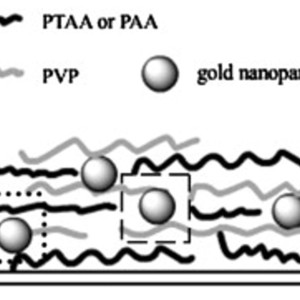Self-Assembly of Multilayer Films Containing Gold Nanoparticles Via Hydrogen Bonding
Citation
Yan Jiang, Yi Shen, and Peiyi Wu*. Self-Assembly of Multilayer Films Containing Gold Nanoparticles Via Hydrogen Bonding. J. Colloid Interface Sci. 2008, 319, 398-405.
Abstract
Polymer/Au nanoparticle multilayer ultrathin films are fabricated via hydrogen-bonding interaction by a layer-by-layer technique. The Au nanoparticles surface-modified with pyridine groups of poly(4-vinylpyridine) (PVP) are prepared in dimethyl formamide (DMF). Transmission electron microscopy (TEM) image shows that uniform nanoparticles are dispersed in the PVP chains. Poly(3-thiophene acetic acid) (PTAA) and poly(acrylic acid) (PAA) are utilized to form hydrogen bonds with PVP, respectively. Considering the pH-sensitive dissociation behavior of PTAA and PAA, we investigate the release behavior of the Au-containing multilayers at different pH values in this work. UV–vis spectroscopy and atomic force microscopy (AFM) are employed to monitor the buildup and the release of the multilayers. The results indicate that in the films assembled with gold nanoparticles, the polymers are difficult to be removed from the substrate. The interaction between the gold particles and the neighboring PVP chains is responsible for the phenomenon. Gold particles act as physical cross-link points in the multilayers. Due to the additional interaction caused by the gold nanoparticles in the films except the hydrogen-bonding interaction between PTAA (or PAA) and PVP, the stability of the Au-containing multilayer film is ensured even though the changes in pH values may result in the break of the hydrogen bonds.


